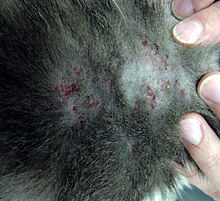- Miliary dermatitis
-
Miliary dermatitis is a descriptive term used in veterinary medicine to describe a multifocal distribution of skin lesions, with no identifiable pattern. The term miliary means millet-like, as the feel of running one's hands through the coat of an affected cat is comparable to the feeling if a cat's coat contains millet seeds.
Contents
Causes
Miliary dermatitis is classified as a cutaneous reaction pattern of inflammation and can be the manifestation of a wide variety of skin allergies, infections or parasitic infestations. The majority of cases are associated with feline flea allergy dermatitis.
Symptoms
Cats with miliary dermatitis have a rash consisting of fine papules surmounted by small crusts. The rash can be widespread or it can be concentrated on the back of the neck and shoulder blade area or on the underside of the abdomen. Secondary infection with Staphylococcus intermedius is common. Many affected cats show signs of itchiness, and some may groom their coat excessively resulting in bald areas, but some are not apparently bothered with the rash.
Treatment
The basis of the treatment is identification and management of the underlying cause. Cats may also be treated with antibiotics and cortisone drugs. The disease may be chronic and recurrent.
See also
References
- Medleau, Linda; Keith A Hnilica (2006). Small Animal Dermatology A Color Atlas and Therapeutic Guide. St. Louis, Missouri: Saunders Elsevier. ISBN 978-0-7216-2825-7.
- Scott, Danny W.; William H. Miller, Jr; Craig E Griffin (2001). Muller & Kirk's Small Animal Dermatology 6th Edition. Philadelphia, PA: WB Saunders Company. ISBN 978-0-7216-7618-0.

This veterinary medicine–related article is a stub. You can help Wikipedia by expanding it.

